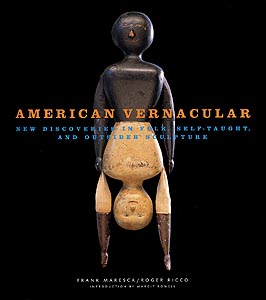|
In the vernacular, mostly
 American Vernacular: New Discoveries in Folk, Self-Taught and Outsider Sculpture
American Vernacular: New Discoveries in Folk, Self-Taught and Outsider Sculpture
By Roger Ricco and Frank Maresca, Bulfinch Press/Little, Brown and Company, Boston, color reproductions, 304 pages, 2002. ISBN 0-8212-2780-7
Between their exquisite taste and commensurate connections in the art and antiques worlds, Roger Ricco and Frank Maresca reliably show some of the best self-taught, vernacular and outsider art -- both in their gallery and in their well-designed books.
American Vernacular follows American Self-Taught, which dealt with two-dimensional work, and American Primitive, their first big survey of sculptural objects. The new book reorganizes the chapters somewhat, but follows the same format as American Primitive, with new pieces plugged in throughout, and all reproduced in color this time.
"Vernacular" is a reasonably unifying theme for the carnival displays, commercial figures, decoys, weather vanes, canes, baskets, jugs and a number of the figures and busts that in many contexts would be labeled folk. Most of this work reflects popular, if not always traditional, aesthetics, vocabularies and techniques. That's a reasonable fit as well for, say, William Edmondson, Elijah Pierce or Edgar Tolson, but it's hard to see its applicability to some of the other usual self-taught/outsider suspects that make an appearance, such as Thornton Dial, Eugene von Bruenchenhein, James Castle, Judith Scott or even David Butler. There may be a case for a broad affinity among the self-taught. But if it's made here it's only a visual argument, and the extent to which these artists' work is jarring points out an aesthetic divergence that if anything brings into question the relevance of the self-taught concept.
The authors make a more convincing argument for the affinity of certain commercially made material with handcrafted work, by the visual evidence anyway. An introductory essay by Joseph Jacobs also presents a brief but helpful history of how the mainstream art world's relationship to this kind of work has had an enormous impact on its fate in the public eye and in the market place.
The point of this book is not the text, however, but the objects, and the new examples in American Vernacular are just as engaging as those in the earlier books. Like all the Ricco/Maresca volumes, this publication also demonstrates the importance of presentation. Diamonds will often shine in the rough, but when well photographed and set against proper backgrounds they shine that much brighter. With a few exceptions, the work here shines brightly indeed.
|